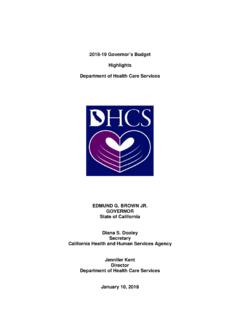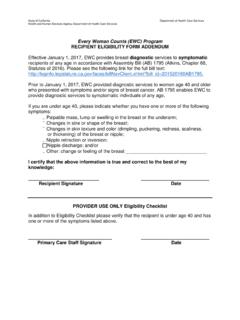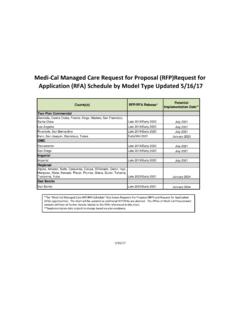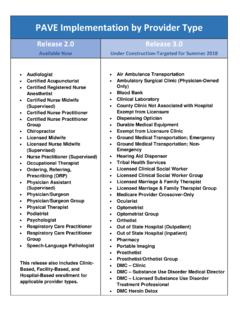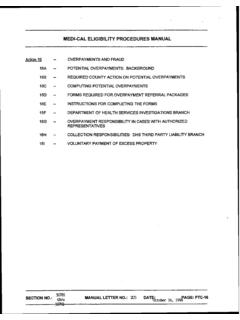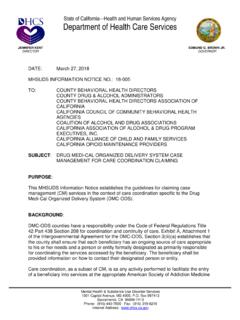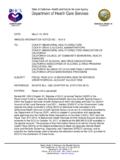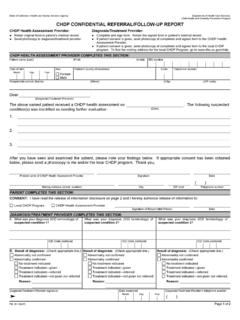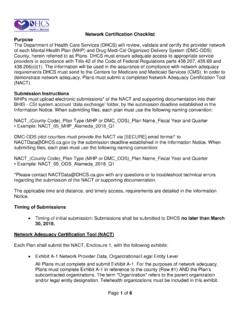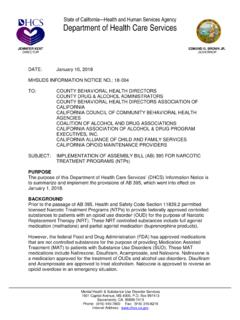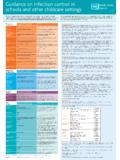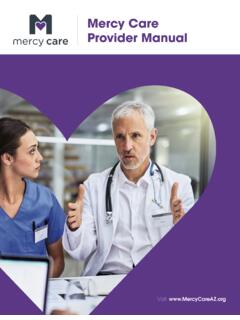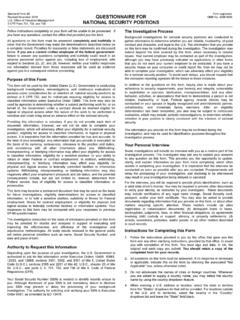Transcription of Medication Assisted Treatment Toolkit for Counselors
1 Medication Assisted Treatment Toolkit for Counselors This resource was created by Harbage Consulting with support from the Department of Health Care Services 1 Medication Assisted Treatment Toolkit for Counselors Chapters PART ONE Basic Overview of Medication Assisted Treatment (MAT) PAGE 3 PART TWO What do Counselors Need to Know to Help Patients with MAT? PAGE 10 PART THREE Where can I Find More Information? PAGE 15 GLOSSARY OF TERMS Acamprosate: Medication that reduces the craving Buprenorphine: Medication that makes the brain to drink alcohol. think it is still receiving the problem opioid. It stops cravings and withdrawal symptoms and blocks the Alcohol Use Disorder (AUD): Drinking that is prob-efect of other opioids. It can be given in a doctor s lematic and becomes severe is given the medical di-ofice, clinic, or narcotic Treatment program (NTP). agnosis of AUD. AUD is characterized by compulsive alcohol use, loss of control over alcohol intake, and a Chronic Disease: Long-lasting conditions that usual-negative emotional state when not drinking.
2 Ly can be controlled but not cured. People living with chronic illnesses often must manage daily symptoms. Benzodiazepine: A class of drugs used to relax the central nervous system, commonly used to treat anxi-ety, seizures, and trouble sleeping. CONTINUED ON NEXT PAGE This resource was created by Harbage Consulting with support from the Department of Health Care Services Page 1 Alcohol Use Disorder (AUD): Drinking that is problematic and becomes severe is given the medical diagnosis of AUD. AUD is characterized by compulsive alcohol use, loss of control over alcohol intake, and a negative emotional state when not : A class of drugs used to relax the central nervous system, commonly used to treat anxiety, seizures, and trouble Disease: Long-lasting conditions that usually can be controlled but not cured. People living with chronic illnesses often must manage daily Continued from previous page GLOSSARY OF TERMS DATA 2000 Waiver: A special training available to Narcotic Treatment Program (NTP): NTPs are the physicians, nurse practitioners, and physician assis-only settings allowed to ofer methadone.
3 In addition tants that allows them to prescribe buprenorphine. to methadone, they ofer other medications, counsel-ing, and recovery services. Disulfiram: Medication used to treat AUD. Causes se-vere vomiting if someone drinks alcohol after taking it. Obstetrician: Doctor who specializes in pregnancy and childbirth. Hepatitis C: Hepatitis C is a virus that causes inflam-mation of the liver. Hepatitis C often does not have Opioid Use Disorder (OUD): A pattern of behavior symptoms early on. Without Treatment , hepatitis C characterized by craving, increased tolerance, with-may lead to cirrhosis (scarring and damage in the drawal when use stops, and persistent use of opioids liver), liver failure, and liver cancer. It is spread through despite adverse consequences. This includes the contact with infected blood, most commonly by shar-misuse of prescription opioids and the use of heroin ing needles and unprotected sex. or fentanyl. HIV: HIV stands for human immunodeficiency virus.
4 Outpatient Substance Use Disorder (SUD) Pro-It is a condition that harms the immune system by vider: Outpatient Treatment programs are programs destroying the white blood cells that fight infection. where patients come for services during the day People with HIV are at risk for serious infections and rather than staying at the facility. They typically ofer certain cancers. It is spread through contact with in-counseling, case management services, and recovery fected blood, most commonly by sharing needles and services, and may ofer MAT. unprotected sex. Relapse: Return to use after a period of abstinence Medication Assisted Treatment (MAT): MAT uses from using an addictive substance. medications with counseling to treat the whole pa-tient. MAT stabilizes the brain, controlling cravings and Residential Treatment Facilities: Residential helping patients do the hard work of recovery. Treatment facilities ofer 24-hour care for individuals seeking Treatment for SUD.
5 They typically ofer coun-Methadone: Medication that makes the brain think it seling and group therapy, and may ofer other forms of is still receiving the problem opioid. It stops cravings therapy and enrichment activities. and withdrawal symptoms but does not block the efect of other opioids. It can only be given in a highly Substance Use Disorder (SUD): Problematic use of regulated NTP setting. alcohol and/or other substances causing significant problems, including health problems, disability, and Naloxone: Medication that reverses an opioid over-failure to meet major responsibilities at work, school, dose. Naloxone works by temporarily blocking the or home. opioid receptors in the brain. Withdrawal: The feeling of sickness that happens Naltrexone: Medication that blocks the opioid re-when someone stops using an addictive substance. ceptors in the brain. Can be taken as a daily pill or an injection that is efective for one month. Page 2 DATA 2000 Waiver: A special training available to physicians, nurse practitioners, and physician assistants that allows them to prescribe : Medication used to treat AUD.
6 Causes severe vomiting if someone drinks alcohol after taking C: Hepatitis C is a virus that causes inflammation of the liver. Hepatitis C often does not have symptoms early on. Without Treatment , hepatitis C may lead to cirrhosis (scarring and damage in the liver), liver failure, and liver cancer. It is spread through contact with infected blood, most commonly by sharing needles and unprotected : HIV stands for human immunodeficiency virus. It is a condition that harms the immune system by destroying the white blood cells that fight infection. People with HIV are at risk for serious infections and certain cancers. It is spread through contact with infected blood, most commonly by sharing needles and unprotected Assisted Treatment (MAT): MAT uses medications with counseling to treat the whole patient. MAT stabilizes the brain, controlling cravings and helping patients do the hard work of : Medication that reverses an opioid overdose. Naloxone works by temporarily blocking the opioid receptors in the : Medication that blocks the opioid receptors in the brain.
7 Can be taken as a daily pill or an injection that is efective for one Treatment Program (NTP): NTPs are the only settings allowed to ofer methadone. In addition to methadone, they ofer other medications, counseling, and recovery Use Disorder (OUD): A pattern of behavior characterized by craving, increased tolerance, withdrawal when use stops, and persistent use of opioids despite adverse consequences. This includes the misuse of prescription opioids and the use of heroin or Substance Use Disorder (SUD) Provider: Outpatient Treatment programs are programs where patients come for services during the day rather than staying at the facility. They typically ofer counseling, case management services, and recovery services, and may ofer Treatment Facilities: Residential Treatment facilities ofer 24-hour care for individuals seeking Treatment for SUD. They typically ofer counseling and group therapy, and may ofer other forms of therapy and enrichment activities.
8 PART ONE: Basic Overview of Medication Assisted Treatment 3 What is Medication Assisted Treatment (MAT)? Addiction is a disease. Treatment works. Recovery is possible. MAT uses medications with counseling to treat the whole patient. Addiction is a chronic disease, meaning that it does not have a cure and patients will have to manage their symptoms. In this way, it is similar to diabetes or heart disease. Long-term opioid or alcohol use damages the part of the brain responsible for motiva-tion, organization, human bond-ing, and rewards. MAT stabilizes the brain, controlling cravings and helping patients do the hard work of recovery. FDA-approved Medication Counseling and behavioral therapies Whole patient approach to Treatment WHAT IS MAT? + = Why should patients take medications? Without MAT, patients with opi-or contract HIV and hepatitis C for patients with AUD or OUD, oid use disorder (OUD) are at high by sharing or using dirty nee-there are currently no medications risk of using again and possibly More Treatment settings are approved for methamphetamine overdosing.
9 Patients with alcohol beginning to embrace MAT as a (meth) or other substance use use disorder (AUD) who do not best practice for OUD and AUD disorders (SUDs). Patients should receive MAT are less likely to stay because of the strong evidence talk to their medical provider sober. MAT reduces the chances of behind it. Recent court cases and about any other substances that relapse. It also reduces many other legislation have also reinforced they may be using. For example, risks. For example, methadone and Treatment providers obligation if they also use meth or benzodi-buprenorphine help people stop to provide access to MAT for the azepines like Xanax or Valium, using illicit opioids. As a result, patients they they are less likely to be arrested, While MAT is a best practice CONTINUED ON NEXT PAGE 1 National Institute on Drug Abuse. Efective Treatments for Give Inmate Addiction Treatment . May 4, 2019. Available at Opioid Addiction. Available at ; 2 NPR, Setting Precedent, A Federal Court Rules Jail Must SB 992, 2018.
10 Available at NPR, "Setting Precedent, A Federal Court Rules Jail Must Give Inmate Addiction Treatment . May 4, 2019. Available at ; SB 992, 2018. Available at 3 MAT uses medications with counseling to treat the whole patient. Addiction is a chronic disease, meaning that it does not have a cure and patients will have to manage their symptoms. In this way, it is similar to diabetes or heart disease. Long-term opioid or alcohol use damages the part of the brain responsible for motivation, organization, human bonding, and rewards. MAT stabilizes the brain, controlling cravings and helping patients do the hard work of Medication plus Counseling and behavioral equals whole patient approach to treatmentWithout MAT, patients with opioid use disorder (OUD) are at high risk of using again and possibly overdosing. Patients with alcohol use disorder (AUD) who do not receive MAT are less likely to stay sober. MAT reduces the chances of relapse. It also reduces many other risks.
